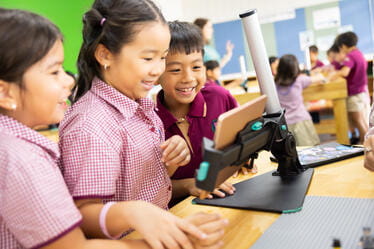APP Year 4 Active Planet IPC Fun Year 4s are really getting stuck in to their IPC topic ‘The Active Planet’. There have been many highlights including learning about forces of nature through peer presentations, a chance to ask a real live geologist questions via Skype and a disaster relief workshop led by Amelie’s mum.
Year 4s are really getting stuck in to their IPC topic ‘The Active Planet’. There have been many highlights including learning about forces of nature through peer presentations, a chance to ask a real live geologist (Tilly’s grandfather, John Chambers) questions via Skype and a disaster relief workshop led by Amelie’s mum, Annabelle who is experienced in humanitarian aid work. We hope you enjoy reading about our learning and, of course, we would like to thank John Chambers and Annabelle Audier for sharing their expertise with us. Well done to Anjali in Year 4 for providing us with a detailed account of her interview with John Chambers.
Peer Presentations
Children in Year 4 worked in groups to research a type of natural disaster of their choice. First they generated questions that they would like to answer in their project. The next step was to find relevant information to answer these questions. Once they had selected the relevant information they organised it in a presentation. In order to teach others about their specialist areas, children had to become experts in their chosen field and the children quickly proved that this was the case. Learning from their peers was a mutually beneficial process for the students. The final stage was to evaluate their presentations and judge how effective each group had been. Now that the students had an understanding of why these disasters happen, they were ready to find out more about how to help people who are caught up in them.
Disaster Relief Workshop with Annabelle Audier
The Year 4 classes were privileged to find out more about disaster relief in a session with Annabelle this week. Annabelle shared her experiences in the aftermath of the Indonesian tsunami in 2004 and a Nepali earthquake and helped our students develop their understanding of what it would be like to be involved in a natural disaster. Our students decided that they would firstly need shovels, warmth, strong people, family, water, food, oxygen and medical supplies to help them survive. The next level of help they would require was transport, tents/ portable housing, tools e.g. a knife, torches, warmth, shoes, clothes and hospital care. The students were very interested to hear about how people from different countries help those affected by natural disasters and see pictures of what it was really like.

Skype with John Chambers written by Anjali in Year 4
I was very lucky to skype with Tilly’s grandad along with a few other kids: Allen, Tilly, Sam, Valerie and Vivi.
His name is John Chambers and he is an expert at volcanoes.
These are some of the questions we asked him and the answers we got.
1. | What was the worst devastation you have ever seen and where was it? The worst devastation I have ever seen was in Sumatra where a volcano erupted and even after a few days it felt as it was snowing. But it was actually white ash. |
2. | Why did you go to Indonesia and Antarctica and what were they like? I went to Antarctica to find out what different types of rocks there are and to Indonesia to learn more about volcanoes. |
3. | What will you do if a random volcano erupted? Well, most people would run away but I would watch it erupting if I had a chance. |
4. | Will people die if a volcano erupts and can you watch one erupt? The answer to both of those questions is yes. |
5. | When did you start exploring? I started exploring when I was young and I used to cycle all over the city I lived in. When I was a teenager I went to France with my friend and we cycled all over. |
6. | What types of rocks do you find in a volcano eruption? You can find gravel and also many others. The rocks that explode out are like huge bombs. |
Other than this, Tilly’s grandad also told us about different things. These are some of the things he told us.
1. He told us that he had visited a volcano named Krakatoa in Indonesia exactly 100 years after its eruption.
2. He also told us about dormant volcanoes which he said is also called sleeping volcanoes and that those types of volcanoes are not likely to erupt again.
3. There are different types of volcanoes and he told us about one which he said the volcano is flat and when the lava comes out it comes out slowly therefore it is less dangerous.
He also showed us some pictures that he had drawn showing the earth's layers and the different volcanoes.
Jude Handscombe, Year 4 teacher and Milepost 2 Leader







.jpg?h=2946&iar=0&w=5238&rev=6f312901a89648a3a855731fb93a6afb&hash=4191121C56801E2F272B6F07C7C2293E)

